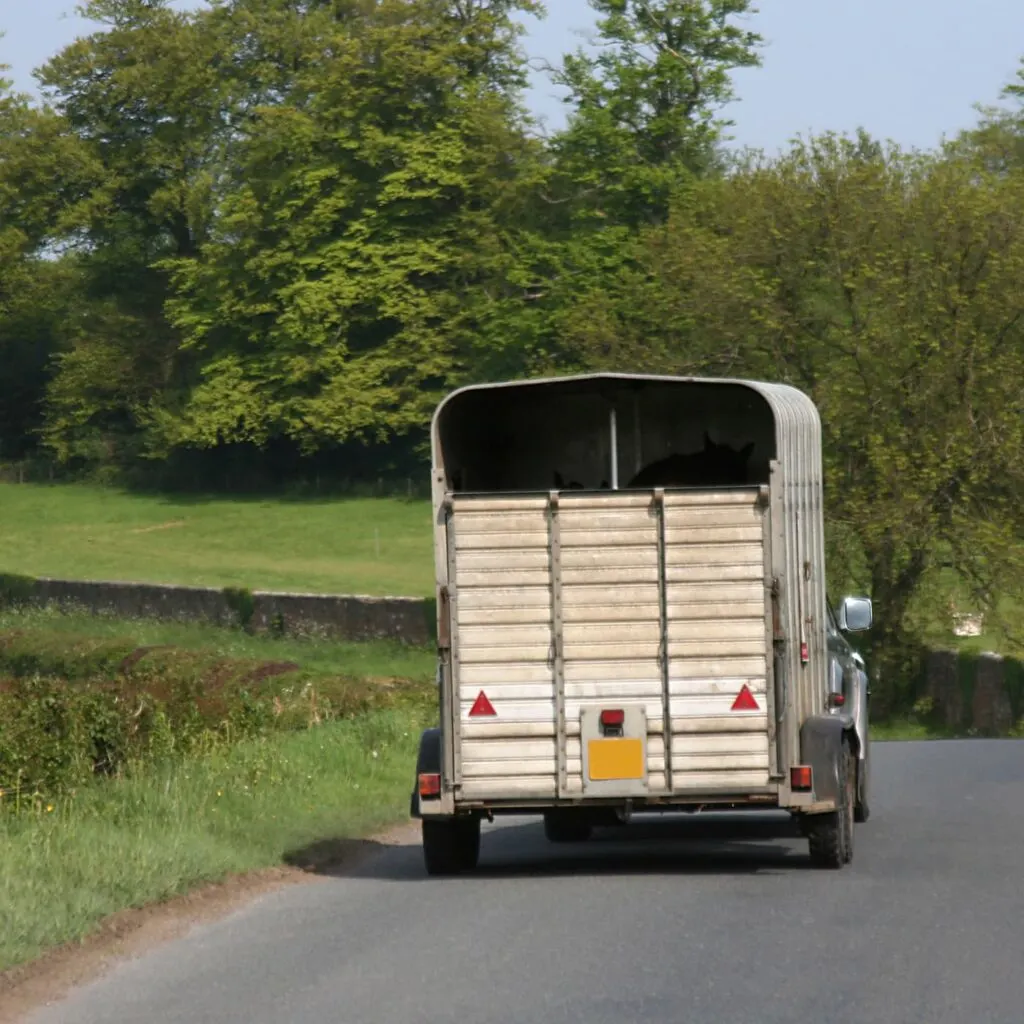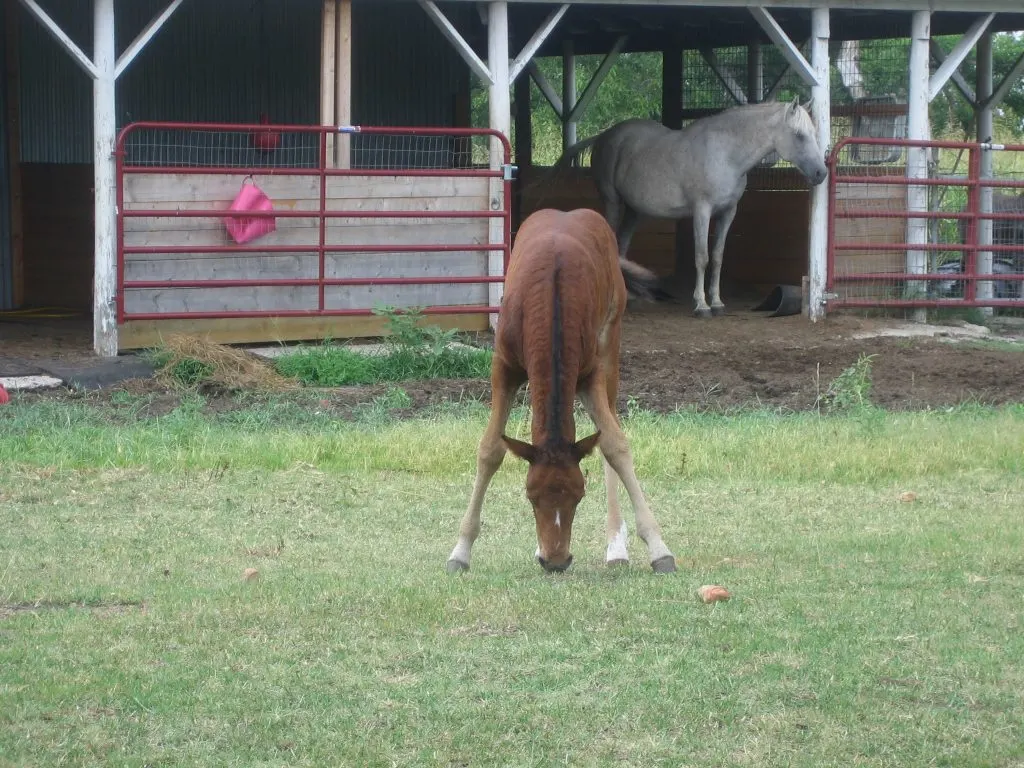Tips for that first crucial first trailer ride home with your brand new horse.
Since weanlings generally lack the patience to tie quietly or the experience to stay calm in a horse trailer, it’s best to haul a weanling in a horse trailer that allows them space to move around and stand in whatever way is comfortable for them.
Professional haulers, who often have cameras in their trailers, report that young horses move around quite a bit during their first trailer ride, but with that freedom to move, they soon find the best way to stand in a moving trailer. A little extra space allows a young horse some room to experiment with getting their balance in the trailer.
The best trailer for hauling a weanling horse is a stock trailer or a slant load horse trailer with dividers removed. A straight load to horse trailer can also work if the divider between the two horse stalls can be cleanly removed as well as any chest bar or front partition. For loading foals, weanlings, and inexperienced yearlings, it’s best to modify your trailer to be as close as possible to a simple, uncomplicated box stall.
As much as possible, handle your foal before suddenly trying to load them in a trailer. Researchers have found that early contact with humans helps decrease stress responses to novel situations as they grow.
Questions about Hauling Weanlings with Halters
While horse professionals agree that foals and weanlings should not be tied in a trailer, breeders are split on the issue of whether foals and weanlings should wear a halter while being transported in a horse trailer.
Although adult horses are almost always trailered with a halter, some breeders remove the halter from foals, weanlings, and unhandled yearlings once they’ve been loaded, and then put the halter back on the horse just before unloading.
This split is due to disagreement on which is more dangerous: the risk of a young horse getting a halter caught on something in the trailer vs the risk of a trailer accident resulting in a horse loose on the highway without the equipment needed to catch it.

Whether you keep a halter on your weanling horse during its first trailer ride is a personal decision that should be informed by the amount of handling that your horse has had, the safety of your trailer, and how well fit your foal’s halter is.
Investing in a very adjustable halter and taking the time to make sure that it fits well- without big gaps between the strap and the horse’s skin- is a best practice to reduce the chance of a halter getting caught on something. Many horse breeders will include a breakaway leather halter with the sale of a young horse.
Pro tip: fitting halters on young horses can be a challenge! Before you go to pick up your new foal, purchase several suckling, weanling, or pony size halters. Having a few handy to try can help ensure that you have a well-fitting halter for the trip home. As long as they are clean, the halters that don’t fit can be returned.
You may be tempted to save money by purchasing a cheap halter for your weanling’s trip home since your foal will grow out of it so quickly, but we find that tiny foal halters make charming keepsakes- especially when they are made from quality leather and have an engraved nameplate attached.
Loading your weanling into a horse trailer for the first time
The practice of loading and unloading your weanling will vary dramatically depending on how much handling your foal has had. Some weanlings will react strongly to the “scary experience” of being loaded on a trailer, while others – typically those with more handling – will readily hop on board. Here are the methods we use to load weanlings in horse trailers:
Mare and Foal Together
Ideally, the breeder you have purchased your weanling from has taken the time to load and unload the broodmare with your foal at her side a few times. Simply walking through this process with mares and baby horses can make loading weanlings after a sale much easier. Although less ideal, this method can also be used to load unweaned foals for solo transport.
Loading a mare and foal together and removing the mare may be somewhat easier than loading an unweaned young horse without its mother. If at all possible, foals should be weaned before being transported in a trailer for the first time, although this is not always possible due to logistics.

Traditional Loading
If you’re buying from a reputable horse breeder, there is a good chance that your weanling will have basic ground manners and know how to walk on a halter and lead quietly. If your weanling has had this opportunity for training, loading typically becomes much easier. A foal that trusts humans and is used to following them may readily load alongside a handler walking them up a ramp into a horse trailer.
Loose Loading
Perhaps the easiest way to transport unhandled foals, weanlings, and young horses, loose loading is often safer for both horse and handler. This method involves positioning a trailer adjacent- or inside- a round pen, corral, or paddock fence. Ideally, the young horse is given a few days for their natural curiosity to prompt them to explore the interior of the trailer – a process which can be sped by placing the young horse’s food inside the trailer.
When loading needs to happen quickly – such as an out-of-state pickup or quick sale, loose loading onto the position trailer can be accomplished through using round pen panels to “squeeze” the horse towards the trailer, or gentle lunging to encourage the horse to enter the trailer to avoid exercise.
When loading a young horse into horse trailer for the first time, always trying to load on a soft surface such as dirt or grass. Young horses are unpredictable, and loading or unloading might be eventful. Grass and dirt give both traction and cushion that cement, gravel, and concrete don’t.
Preparing your horse trailer to haul a foal
Before loading a foal or weanling on your horse trailer, inspect your trailer from the point of view of a small panicked horse. There may be safety hazards that the older, more seasoned horses you’ve hauled haven’t exposed.
1. Use heavy-duty duct tape or gorilla tape to cover any edges that stand out or have a sharp edge.
2. If your trailer has windows or openings for feeding, make sure they are secured closed and double check that they can’t be opened by a strong blow from the inside. Trailer maintenance companies can add extra bolts if there are security concerns.
3. Many seasoned foal haulers recommend covering any windows in the trailer, though this may not be necessary.
4. Place fresh hay on a pile on the floor before loading. Do not use a haynet to feed young horses hay while hauling.
Preparing your Foal to enter a horse trailer for the first time
1. If possible, expose your young horse to loading and unloading on a horse trailer multiple times before the first ride.
2. Try and make your interaction with your foal as positive as possible. If your weanling is unhandled and you expect loading to be dramatic, distance yourself from the process by using a loose loading method(this can help ensure that even though loading might be a scary experience, it’s not an experience they associate with you.)
3. Check and double-check that you have a well-fit halter for your weanling (but you may want to remove it once the foal is loaded.)
4. Do not use any excess tack such as blankets, leg wraps, or shipping boots. For young horses, these are more of a hazard than protection.
For troubleshooting issues loading, be sure and check out our article on preventing and dealing with horse trailer loading refusals.
How old does a foal need to be before it can travel?
Foals younger than weanling age can be trailer with its mother as early as the first week of their life. For trailering without the mare, foals should be of weanling age (usually about six months old).

